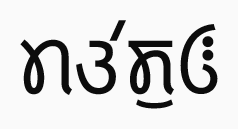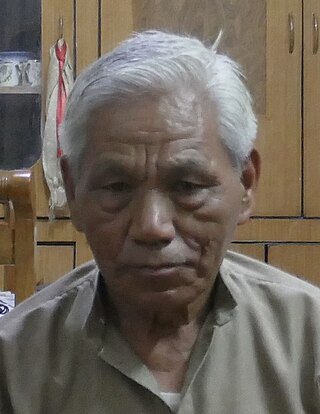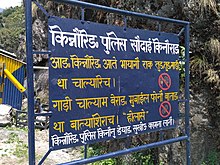
Kinnaur district is one of the twelve administrative districts of the state of Himachal Pradesh in northern India. The district is divided into three administrative areas and has six tehsils. The administrative headquarters of the district is at Reckong Peo. The revered Kinnaur Kailash mountain, one of the Panch Kailash sites, is situated in Kinnaur. As of 2011, it is the second least populous district of Himachal Pradesh, after Lahaul and Spiti.
The Western Pahari or Himachali is a group of Northern Indo-Aryan languages or a dialect continuum spoken in Northern India, primarily in the state of Himachal Pradesh and Jammu.
Sangla is a town in the Baspa Valley, also referred to as the Sangla valley, in the Kinnaur District of Himachal Pradesh, India, close to the Tibetan border.

Chhitkul is a village in Kinnaur district of Himachal Pradesh. During winters, the place mostly remains covered with the snow and the inhabitants move to lower regions of Himachal.
Sunam is an underdocumented Sino-Tibetan language spoken in Sunnam village, Kinnaur district, Himachal Pradesh, India.

Nako is a village in the Himalayas of northern India, located near the Indo-China border in the Trans-Himalayan region of Kinnaur district in Himachal Pradesh. Nako Lake is a prominent feature here where it borders the village. Nako Monastery, dated to 1025, is located in the village as well as several other Buddhist chortens.
The West Himalayish languages, also known as Almora and Kanauric, are a family of Sino-Tibetan languages centered in Himachal Pradesh, Uttarakhand and across the border into Nepal. LaPolla (2003) proposes that the West Himalayish languages may be part of a larger "Rung" group.
The Lahuli–Spiti languages the exonym for a subgroup of the Tibetic languages related to the (Stöd) Ngari Tibetan spoken in the Lahaul and Spiti region of Himachal Pradesh, India, belonging to the South-Western group of Tibetic languages, earlier classified as Western Innovative Tibetan. They are more closely related to Standard Tibetan than to the neighboring Ladakhi–Balti languages spoken further north.
Shumcho is an underdocumented Sino-Tibetan language spoken in Kinnaur district, Himachal Pradesh, India.
Jangshung is an underdocumented Sino-Tibetan language spoken in Kinnaur district, Himachal Pradesh, India. Most Jangshung speakers reside in the villages of Jangi, Lippa and Asrang. They belong to the upper caste, while the lower castes in the same villages speak Shumcho, a related but distinct language of the Kinnauric branch.

Mahasu Pahari is a Western Pahari language spoken in Himachal Pradesh. It is also known as Mahasui or Mahasuvi. The speaking population is about 1,000,000 (2001). It is more commonly spoken in the Himachal Pradesh, Shimla (Simla) and Solan districts. It is to be known that Shimla and Solan were parts of the old Mahasu district. Himachal Pradesh State on 1 September, 1972 reorganised the districts dissolving Mahasu district. The Solan district was carved out of Solan and Arki tehsils of the then Mahasu district and tehsils of Kandaghat and Nalagarh of the then Shimla District of Punjab.

Pahari Kinnauri, or Kinnauri Pahari, also known as Oras Boli, is a Western Pahari of northern India. It is spoken by different tribal groups in Kinnaur District, Himachal Pradesh; the language used to be commonly known as 'Kinnauri Tribal language', but this is now considered a derogatory term. It is not clear how distinct it is from other varieties of Himachali.

The Bodh people, also known as Khas Bhodi, are an ethnic group of Himachal Pradesh, India. They are found in Lahaul tehsil, Lahaul and Spiti district, predominantly in the Bhaga and Chandra valleys, but also to a lesser extent in Pattani valley, Miyar Valley, in the upper reaches of Pangi, Himachal Pradesh and Paddar valley, Jammu and Kashmir. Their religion is predominantly Buddhism with animistic and shaivite practices. Caste wise, they are identified as Rajput, Thakur or Kshetri although caste rules are not as rigid as in the plains. Historically, 3-4 prominent families of the area were accorded the titles of Rana, Wazir or Thakur by the kings of Chamba, Kullu or Ladakh for the purpose of general administration and revenue collection. They have a mix of martial traditions alongside shamanistic and lamaistic beliefs. Certain families/clans used to be significant zamindars/jagirdars. There is a significant cultural and ethnic mixing due to the region passing under the hegemony of rulers of Ladakh, Kullu and Chamba over the last many centuries. The language spoken differs from valley to valley with some dialects being very close to Kumaoni, while others are mixed with Chambyali and Dari. They are progressive, enterprising, honest and were involved in the centuries old India-Tibet-Nepal trading routes. Organized into family groups/clans with clan names ending in the suffix "-pa" similar to the "-ta" suffix found in the family/clan names of the Simla area.
Chitkuli Kinnauri is a language spoken in Kinnaur district of Himachal Pradesh, India. It is spoken in two villages in the Sangla division of Kinnaur - specifically in Chitkul and Rakchham villages. The number of speakers as per Ethnologue was 1060 in 1998.
Bhoti may refer to several Tibetic (Sino-Tibetan) languages spoken in India:
Bhoti Kinnauri is a Tibetic language spoken in the Lahaul and Spiti region of Himachal Pradesh, India. It forms a closely knit group with other Lahuli–Spiti languages, and is fairly close to Standard Tibetan.

The Bhaba valley is a valley in the northern Indian state of Himachal Pradesh. It is formed by the Bhaba river in the district of Kinnaur, which originates near Bhaba Pass. Bhaba valley is constituted by in total five panchayats of Bhaba Nagar tehsil. The Wangtu bridge is the gateway to the valley. There are 17 villages within the valley. These villages are in turn divided into five Panchayats: Katgaon, Yangpa 1, Ynagpa 2, Kraba and Kafnu. Most of the valley's inhabitation is in Katgaon village.
Stod Bhoti (sTodpa), occasionally known as Lahul Bhoti or Lahuli, is a Tibetic language spoken in the Lahaul and Spiti district of Himachal Pradesh, India. It forms a closely knit group with other Lahuli–Spiti languages, and is fairly close to Standard Tibetan.

Pangwali is a Western Pahari language of Himachal Pradesh, India. It is spoken in the Pangi Tehsil of Chamba district, and is threatened to go extinct. Pangwali is natively written in the Takri script, but Devanagari is used as well. It is very similar to the Padderi language of Padder, J&K.

Tobdan is a historian and linguist from Himachal Pradesh, India. He is noted for his work on the cultural traditions, histories, and languages of the Lahaul and Spiti district, and some neighboring regions.










